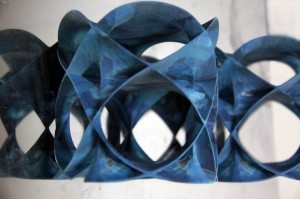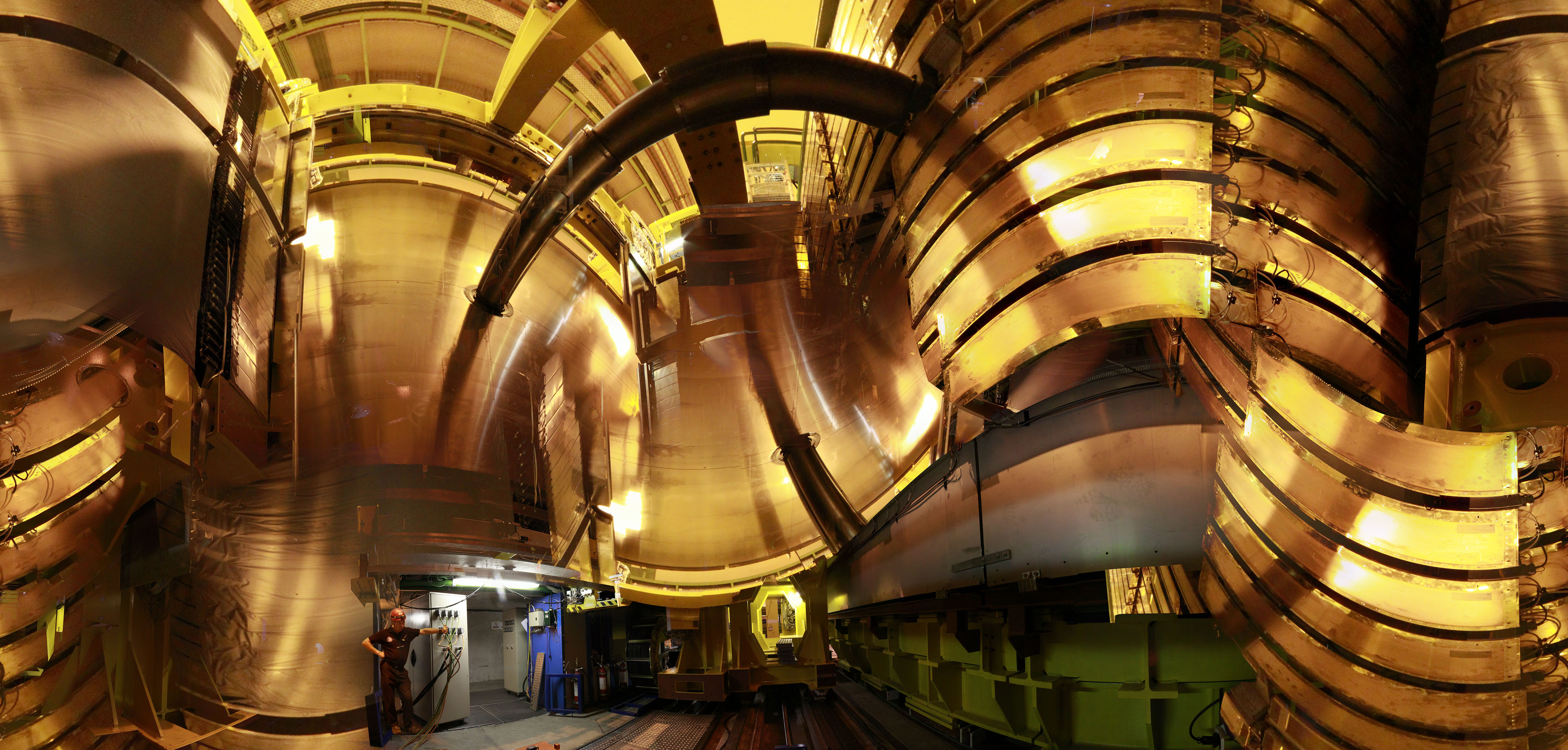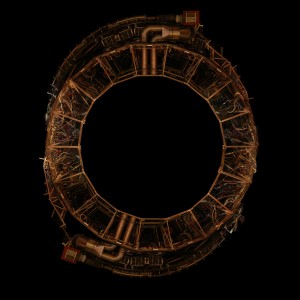A colleague once asked me whether I had ever ‘heard silence’. Oxymoronics aside, this does raise some interesting questions, perhaps which are being indirectly addressed at the Large Hadron Collider (LHC) experiment underneath Geneva. Sound is of course a wave of movement through a medium such as air. Each bit of air doesn’t move much, it’s the overall ‘field’ that carries the sound, which is an emergent phenomenon. This sound movement can be described in physics terms as a ‘phonon’. And to make a ‘phonon’ requires an energy source and a medium to propagate it. So if you take away the medium and / or the energy source, no phonon can come into existence, thus there is no sound.
The core of the LHC, a vacuum tube twenty seven kilometers in circumference, is almost the coldest place in the universe, colder than the depths of space, and an almost perfect vacuum. So within this tube there is no energy (temperature) and no medium (air). Thus it is perhaps the quietest place in the universe (which is a near-practical way to get silence, but even at absolute zero there’s still ‘vacuum energy’, and it would be tricky (and fatal) to get one’s ear inside it!). Yet all around it is a hustle and bustle of noise; cooling systems, pumping systems, scientists and engineers shouting at each other in French, German, English, Russian, Japanese, etc; a real babble.
And yet when they fire up the LHC to full strength (if it indeed works!), areas within the vacuum tube will be turned into one of the most energetic and hottest places in the universe. When they smash particles together with almost as much focused energy as in the hypothetical Big Bang, it will create things so exotic nobody really knows what will happen, or for that matter, what it might sound like, but it will be (metaphorically at least) LOUD.

Figure 1: ‘Calabi-Yau Observatory’, three dimensional plaster and inkjet print, 20 cm x 12 cm x 10 cm
One hope they have is to make manifest the missing piece to the contemporary physics puzzle, an almost mythical particle called the Higgs Boson. This may appear for an instant after a ‘symmetry breaking’ of very high energies, giving evidence that everything in the universe may have once been all exactly the same stuff, a ‘symmetry paradise’. And what might this event sound like? Perhaps like the instant when a beautiful harmonic tone is ‘broken’ by a hyperactive kid jumping on the record player. But the ‘God Particle’ (as they call it) is so exotic, it may even go back in time and stop the LHC working, before they even turn it on. So even if the LHC doesn’t work, it supports the theory that it did. That’s very creative thinking (and its also backed up by some serious maths).
Another big trick they want to do at the LHC is to produce evidence of extra dimensions. This may finally give some empirical evidence to support the latest mutation of particle physics, dubbed ‘M theory’ by the physicist (and former football player) Ted Witten, and it’s got lots of extra dimensions in it. M theory is a meta-superstring theory and doesn’t even exist, really – nobody even knows what the ‘M’ stands for! Superstring theory itself is ‘postmodern physics’ and does not require evidence to be ‘true’, according to its devotees (its opponents of course say that it is therefore not science). Thus the LHC might then ‘re-modernise’ the theory by making experiments that can actually test it out. This is almost a pity, because us artists can have lots of fun with unfalsifiable things. I created several sculptural forms showing what six dimensional space might look like, based on solid mathematics, but taking it to where only the imagination can go (see figure 1). If there is no physical model that can allow us to relate to such abstract concepts, then any picture is as good as any other. This is actually what Niels Bohr, “the father of the atom” said about quantum theory (whilst trying to create common ground between scientists who were fighting over how the equations should be interpreted).

Figure 2: ‘Observing baryogenesis’, digital photographic collage, 250cm x 120 cm
My angle on the beautiful but strange angular forms that make the curled up dimensions (termed Calabi-Yau manifolds) was to embed an ‘extended’ three dimensional world within them stereoscopically, so that the ‘space inside the space’ only appears after doing unpleasant cross-eyed tricks – a bit like trying to digest the idea of six dimensional space.[1]
Some of the other experiments at the LHC are designed to create antimatter, which is simple enough to do, and it’s also easy to comprehend sonically. Antimatter can be seen as being kind of ‘inverted matter’, or according to the tabla player Richard Feynman, it can be portrayed as matter that’s simply traveling the other way through time. Just like playing a tape backwards. The ‘LHCb’ installation detects antimatter (see figure. 2), and, wait for it, beauty (that’s what the ‘b’ stands for). That’s right, aesthetics are still cool in the scientific world!
Yet some of the other experiments are designed to manifest much stranger stuff, and there are those rumours that black holes will come out of it (which may actually be a clever marketing trick). What does a black hole sound like? One can explain it in terms of gravitational warping and extreme spatiotemporal curvature (i.e. speeding up the tape faster and faster until it breaks), wax lyrical about Hawking radiation (jets of energy shooting out the tops of black holes like a pressure cooker’s vent), and so on.[2] But when I think about it I just get the guitar riff to Black Sabbath’s ‘Hole in the Sky’ going around and around in my head.[3]
Thanks to my work at the Australian Synchrotron (initiated by an ANAT artist residency), I somehow managed to get into the Large Hadron Collider, and with my co-conspirators Donna Kendrigan & Volker Kuchelmeister, made lots of photographic, video and sound recordings (http://www.youtube.com/watch?v=7jcCxoOCImA). Our timing was by chance synchronized with the LHC, as the day we went there was the last day one of the big experiments, ALICE, was accessible. We gazed into the heart of this gigantic and insanely complex machine, located deep under the ground, just as they were closing its hundred ton doors (which took hours). It was a breathtaking sight, akin to gazing up at Apollo 12 just before it headed off to the moon. And in fact this is like going to the moon, but instead of going up it’s going down – down in scale to explore the threshold of the ultra-microscopic universe, and it really is weird shit down there! And if it does suck the world down with it in a sci-fi doomsday scenario, well you might as well get a ringside seat!

Figure 3: ‘ALICE IRIS’, digital photographic collage, 300cm x 300 cm
In the meantime, I have been experimenting with sounds and images and data gathered from my accelerator experiences. These experimental pieces include photographic collages (see figures 2 and 3) and sound compositions such as ‘Sounds of Science’, based on my recordings of the LHC machine noises and human babble at the ATLAS control centre (see video below).
One project I am currently developing is a ‘Phonon Accelerator’, using my synchrotron sound recordings and engineering plans for synchrotron magnet assemblies. This is comprised of a circle of speakers built into a customized model of a particle accelerator (see figure 4). Synchrotron beam frequencies (pitch-shifted down so we can hear it) are emitted through consecutive speakers, moving around the circle at an ever increasing rate. This ‘circular sound’ effect will be like hearing the accelerating energy harmonics (dubbed the ‘synchrotron tune’ by accelerator physicists).[4]
So is this what science sounds like? Science is spoken through the language of mathematics, and numbers can be expressed sonically as well as graphically. Music is also just a collection of numbers, or is it? When things are reduced to numbers without context, they have no meaning. It’s the interpretation that makes it all make sense, in science as well as the arts. And so here is a point where the two disciplines cross over. Physicists look for patterns in data to try and understand the theories it relates to, just like one listens for patterns in a piece of music in order to ‘understand’ the sounds in an implicit or emotive way. Heavy metal makes no sense when injected into a particle accelerator, or does it make more sense? One way to find out is to set up an experiment, do it, and see / hear what happens (now that’s science!).

Figure 4:‘Phonon Accelerator’, Z print plaster model, 20 cm x 20 cm x 5 cm
One thing that seems to be revealed through experiment and theory across both art and science is this: our reality vibrates on all levels. Thus we live in a fundamentally musical universe, where there is no such thing as silence.
Chris Henschke
Chris Henschke is an artist who has been working with digital media since 1987. His main areas of research are in sound and visual relationships, interactivity, and art / science hybridisation. His artworks probe the relationships and tensions between matter and energy, light and sound, observation and theory, information and noise. He was Artist in Residence at the Australian Synchrotron, supported by ANAT and Arts Victoria’s Innovation Residency program from October to December 2007, and still does the odd experiment there.
Read More
Watch More
Audio and photo montage of recordings from the Large Hadron Collider ( LHC ) including voices from the ATLAS control room and machines from the ALICE & LHCb underground experiment installations
Taking on the loudest sound system in the world. Captain Satan gets into & samples the Large Hadron Collider at CERN. Here’s the 1st remix experiment of LHCb antimatter antipop, in High Defenition.
References
[1] This is a mutation of my ‘Observatory’ project, supported by the Arts Victoria Arts Innovation fund. This was a ‘visualisation collaboration’ with a string mathematician who basically disagreed with my whole way of interpreting the theory, and then seemed to disappear into his monopole magnetic field research, and was never seen again. The idea of ‘space inside the space’ actually came from a line in a Napalm Death song.
[2] In 2004 I created HyperCollider, a hybrid of a pinball machine, a particle accelerator, a gramophone player and a black hole (well before there was talk about black holes and the LHC) . The online version is hosted by the Stanford University Linear Accelerator, at http://www.symmetrymagazine.org/cms/?pid=1000117)
[3] There are whispers amongst heavy metal experts about the ‘black wind’, a rare phenomenon that occurs when a particularly heavy and tight band hits a note so low and resonant, it momentarily creates a vacuum in the air. Although scientifically feasible, it is also scientifically dubious, partially because no scientist has ever experimentally measured such an event. Does this call for a new type of ‘metal science’? Perhaps such ideas were what Frances d’Ath was moving through with her dance work ‘Science is the new Black Metal’, an ANAT residency with Swinburne University Centre for Astrophysics and Supercomputing.
[4] See the article ‘The Final Experiment’ in Filter edition 68, Winter 2008, for a description about the ‘tune’ of the Australian Synchrotron and how I was able to make it sing the tune of the local cicadas.
 This work is licensed under a Creative Commons Attribution-NonCommercial-ShareAlike 2.5 Australia.
This work is licensed under a Creative Commons Attribution-NonCommercial-ShareAlike 2.5 Australia.







[...] into the heart of some of the giant experiments in the Large Hadron Collider (see youtube video and filter article), I did not get to see any of the experiments. I had hoped to see the test facility setup for CLIC [...]